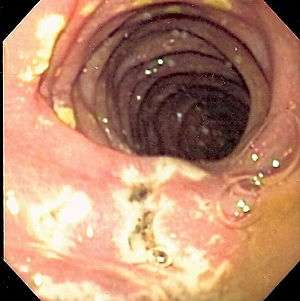Zollinger–Ellison syndrome
| Zollinger–Ellison syndrome | |
|---|---|
 | |
| Endoscopy image of multiple small ulcers in the distal duodenum in a patient with Zollinger–Ellison syndrome | |
| Classification and external resources | |
| Specialty | endocrinology |
| ICD-10 | E16.4 |
| ICD-9-CM | 251.5 |
| MedlinePlus | 000325 |
| eMedicine | med/2437 ped/2472 |
| Patient UK | Zollinger–Ellison syndrome |
| MeSH | D015043 |
Zollinger–Ellison syndrome (ZES) is caused by a non–beta islet cell (islet of Langerhans), gastrin-secreting tumor of the pancreas that stimulates the acid-secreting cells of the stomach (parietal cells) to maximal activity, with consequent gastrointestinal mucosal ulceration. ZES may occur sporadically or as part of an autosomal dominant familial syndrome called multiple endocrine neoplasia type 1 (MEN 1). The primary tumor is usually located in the pancreas, duodenum or abdominal lymph nodes, but ectopic locations have also been described (e.g., heart, ovary, gallbladder, liver, kidney).[1]
Signs and symptoms
Patients with Zollinger–Ellison syndrome may experience abdominal pain and diarrhea. The diagnosis is also suspected in patients without symptoms who have severe ulceration of the stomach and small bowel, especially if they fail to respond to treatment.
- Chronic diarrhea, including steatorrhea (fatty stools)
- Pain in the esophagus, especially between and after meals at night
- Nausea
- Wheezing
- Vomiting blood (digested blood)
- Malnourishment
- Loss of weight due to loss of appetite
Gastrinomas may occur as single tumors or as multiple, small tumors. About one-half to two-thirds of single gastrinomas are malignant tumors that most commonly spread to the liver and lymph nodes near the pancreas and small bowel. Nearly 25 percent of patients with gastrinomas have multiple tumors as part of a condition called multiple endocrine neoplasia type I (MEN I). MEN I patients have tumors in their pituitary gland and parathyroid glands, in addition to tumors of the pancreas.
Pathophysiology
Gastrin works on the parietal cells of gastric glands causing them to secrete more hydrogen ions into the stomach lumen. In addition, gastrin acts as a trophic factor for parietal cells, causing parietal cell hyperplasia. Thus there is an increase in the number of acid-secreting cells, and each of these cells produces acid at a higher rate. The increase in acidity contributes to the development of multiple peptic ulcers in the stomach and duodenum (first portion of the small bowel).
Diagnosis
Clinical suspicion of Zollinger–Ellison syndrome may be aroused when the above symptoms prove resistant to treatment, when the symptoms are especially suggestive of the syndrome, or endoscopy is suggestive. The diagnosis of Zollinger–Ellison syndrome is made by several laboratory tests and imaging studies.
- Secretin stimulation test, which measures evoked gastrin levels
- Fasting gastrin levels, on at least three separate occasions[2]
- Gastric acid secretion and pH. Normal basal gastric acid secretion is less than 10 mEq/hour, while in Zollinger–Ellison syndrome it is usually more than 15 mEq/hour.[3]
- An increased level of chromogranin A is a common marker of neuroendocrine tumors
In addition, the source of the increased gastrin production must be discovered. This is either done using MRI or somatostatin receptor scintigraphy, the investigation of choice.[4]
Treatment
Proton pump inhibitors (omeprazole, and lansoprazole) and histamine H2-receptor antagonists (such as famotidine and ranitidine) are used to slow down acid secretion. Following suppression of gastric acid, symptoms normally improve.
History
Sporadic reports of unusual cases of peptic ulceration in the presence of pancreatic tumors occurred prior to 1955, but R.M. Zollinger and E. H. Ellison, surgeons at Ohio State University first postulated a causal relationship between these findings. The American Surgical Association meeting in Philadelphia in April 1955 heard the first public description of the syndrome; Zollinger and Ellison subsequently published their findings in the Annals of Surgery.[5]
References
- ↑ Zollinger-Ellison Syndrome at eMedicine
- ↑ http://patient.info/doctor/zollinger-ellison-syndrome
- ↑ Elizabeth D Agabegi; Agabegi, Steven S (2008). Step-Up to Medicine. Step-Up. Hagerstwon, MD: Lippincott Williams & Wilkins. p. 192. ISBN 0-7817-7153-6.
- ↑ Jensen RT (2004). "Gastrinomas: advances in diagnosis and management". Neuroendocrinology. 80 Suppl 1: 23–7. doi:10.1159/000080736. PMID 15477712.
- ↑ Zollinger RM, Ellison EH (1955). "Primary peptic ulcerations of the jejunum associated with islet cell tumors of the pancreas". Ann. Surg. 142 (4): 709–23; discussion, 724–8. doi:10.1097/00000658-195510000-00015. PMC 1465210
 . PMID 13259432.
. PMID 13259432.